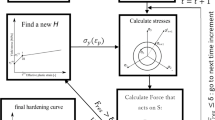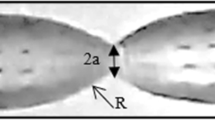Abstract
Quasi-static tensile test is a common, yet fundamental, experiment in determining the mechanical properties of materials. Often, the determination of the equivalent stress–strain relation is complicated by strain localization and necking in the tensile specimen, which results in a triaxial stress state in the specimen and invalidates the assumption of uniaxial tension. In this paper, a three-dimensional full-field Digital Image Correction (DIC) technique is used to obtain all the necessary geometric properties of a cylindrical tensile specimen during necking that are required in determining the Bridgman’s correction method to the true stress–strain relation. Finite element modeling is used to test the applicability of Bridgman’s correction method on three different aluminum alloys to quantify the effect of strain hardening on the triaxiality in the necked region.










Similar content being viewed by others
References
Bao Y, Wierzbicki T (2004) On fracture locus in the equivalent strain and stress triaxiality space. International Journal of Mechanical Sciences. Int J Mech Sci 46:81–98
Mirone G (2008) Elastoplastic characterization and damage predictions under evolving local triaxiality: axysymmetric and thick plate specimens. Mech Mater 40:685–694
Bao Y, Wierzbicki T (2008) A new model of metal plasticity and fracture with pressure and Lode dependence. Int J Plast 24:1071–1096
Driemeier L, Brunig M, Micheli G, Alves M (2010) Experiments on stress-triaxiality dependence of material behavior of aluminum alloys. Mech Mater 42:207–217
Tucker M, Horstemeyer MF, Whittington WR, Solanki KN, Gullett PM (2010) The effect of varying strain rates and stress states on the plasticity, damage, and fracture of aluminum alloys. Mech Mater 42:895–907
Mohammadi M, Brahme A, Mishra R, Inal K (2014) Effects of post-necking hardening behavior and equivalent stress-strain curves on the accuracy of M-K based forming limit diagrams. Comput Mater Sci 85:316–323
Lou Y, Whan J, Huh H (2014) Modeling of shear ductile failure considering a changeable cut-off value for stress triaxiality. Int J Plast 54:56–80
Zhang KS, Li ZH (1994) Numerical analysis of the stress-strain curve and fracture initiation for ductile material. Eng Fract Mech 49:235–241
Coppieters S, Kuwabara T (2014) Identification of post-necking hardening phenomena in ductile sheet metal. Exp Mech 54:1355–1371
Joun M, Eom JG, Lee MC (2008) A new method for acquiring true stress–strain curves over a large range of strains using a tensile test and finite element method. Mech Mater 40:586–593
Kajberg J, Lindkvist G (2004) Characterisation of materials subjected to large strains by inverse modeling based on in-plane displacement fields. Int J Solids Struct 41:3439–3459
Grediac M, Pieeron F (2006) Applying the virtual fields method to the identification of elasto-plastic constitutive parameters. Int J Plast 22:602–627
Kim J, Serpantié A, Barlat F, Pierron F, Lee M (2013) Characterization of the post-necking strain hardening behavior using the virtual fields method. Int J Solids Struct 50:3829–3842
Kadyko M, Dumoulin S, Borvik T, Hopperstad OS (2014) An experimental-numerical method to determine the work-hardening behavior of anisotropic ductile materials at large strains. Int J Mech Sci 88:25–36
Bridgman PW (1952) Studies in large plastic flow and fracture with special emphasis on the effects of hydrostatic pressure. McGraw, New York, 23
Zhang ZL, Hauge M, Odegard J, Thaulow C (1999) Determining material true stress strain curve from tensile specimens with rectangular cross-section. Int J Solids Struct 25:3497–3516
Choung JM, Cho SR (2008) Study on true stress correction from tensile tests. J Mech Sci Technol 22:1039–1051
Alves M, Jones N (1999) Influence of hydrostatic stress on failure of axisymmetric notched specimens. J Mech Phys Solids 47:643–667
La Rosa G, Mirone G, Risitano A (2003) Post necking elastoplastic characterization: degree of approximation in the bridgman method and properties of the flow-stress/true-stress ratio. Metall Mater Trans A 34:615–624
Mirone G (2004) A new model for the elastoplastic characterization and the stress–strain determination on the necking section of a tensile specimen. Int J Solids Struct 41:3545–3564
Sutton MA, Orteu JJ, Schreier HW (2009) Image correlation for shape, motion and deformation measurements: basic concepts, theory and applications. Springer, New York, 66
Zanganeh M, Tai YH, Yates JR (2012) An optical method of measuring anisotropic deformation and necking in material testing. Fatigue Fract Eng Mater Struct 35:842–851
Author information
Authors and Affiliations
Corresponding author
Rights and permissions
About this article
Cite this article
Yu, J.H., McWilliams, B.A. & Kaste, R.P. Digital Image Correlation Analysis and Numerical Simulation of Aluminum Alloys under Quasi-static Tension after Necking Using the Bridgman’s Correction Method. Exp Tech 40, 1359–1367 (2016). https://doi.org/10.1007/s40799-016-0140-7
Received:
Accepted:
Published:
Issue Date:
DOI: https://doi.org/10.1007/s40799-016-0140-7




